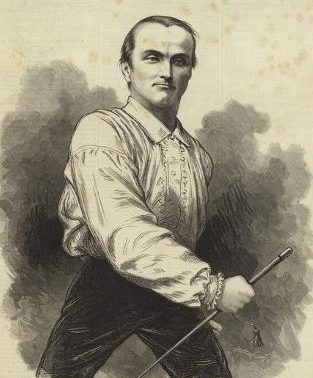When endurance ruled
One hundred and fifty years ago, in an age when sports results were delivered by newspaper and spectators’ attention spans had yet to be eroded by the internet and 24 hour media access, ultra-racing was one of the world’s most popular sports. Some of the most famous Victorian sportsmen were endurance athletes, competing in races that were often over six days, but could be much longer. These gruelling races were perfect for daily newspapers, which reported positions and distances covered at the end of each day. It was like a slow motion version of those internet feeds that send sporting updates to your phone moments after they happen.
One of the greatest athletes of the era was the endurance walker Edward Payson Weston, an American who travelled the world showcasing his extraordinary talents. Walking made Weston a very wealthy man. In 1867 he walked 1,200 miles in 26 days to win $10,000, a huge sum at the time. And he was multi-talented; as well as walking forwards he could walk backwards too, once reversing for 41 consecutive hours, covering 200 miles!
Walking around England
In January 1879 whilst visiting England, Weston decided to combine a lecture tour with a 2,000 mile jaunt around the country on foot. Endurance patron Sir John Astley offered him odds of 5/1 that he wouldn’t be able to complete the task in 1,000 hours. Weston backed himself with £100 and set off from London on 18th January.
Paul Marshall’s account in his fantastic book ‘King of the Peds’ provides a wealth of detail on this epic challenge. From the start it was clear that because of Weston’s fame managing spectators was going to be a challenge. Police and soldiers were brought in to clear a path through throngs of thousands that appeared regularly along the route. Boisterous fans presented a real risk, so Weston’s support team used a decoy, a ‘fictitious Weston’, to draw off the crowds. This backfired when their ruse was discovered and an angry mob pelted Weston’s supporting omnibus with stones.
Outside Winchester Weston was attacked by a group of ‘roughs’, but soldiered on, clocking up a terrific mileage in persistently miserable weather. By the time he reached Nottingham (via Essex, Cornwall, Carlisle and Newcastle) he had covered 1,500 miles but was 200 miles off schedule. He needed a herculean effort to rescue things, and upped the pace as he headed into East Anglia.
By the time he reached Yarmouth he had delivered 50 lectures around the country, encouraging huge audiences to get active, smoke and drink less and eat healthily. His pamphlets and signed photographs sold like hotcakes. At Ipswich a body of 60 soldiers helped him get through an ‘immense concourse’ of well-wishers packing the route. Cutting west across country he entered Oxford with just 130 miles to go, and under two days left before time ran out.
Sadly, Weston’s tired body wasn’t quite up to the final push he needed. He ‘reeled all over the road like a drunken man’ towards London but couldn’t find enough speed. Realising he was going to fall short, Weston stopped for a good breakfast and a rest. When the thousandth hour struck he was just under 23 miles short.
So Weston lost his bet, but reportedly made a big profit once the lecture ticket, pamphlet and photograph sales had been taken into account. And despite the failure, his international reputation only grew. His incredible career continued for many decades, with his final challenge (1546 miles in 51 days) taking place at the venerable age of 74. A century on, details of his achievements are known to only a few, but Weston deserves to be remembered as one of the greatest endurance athletes of all time.



